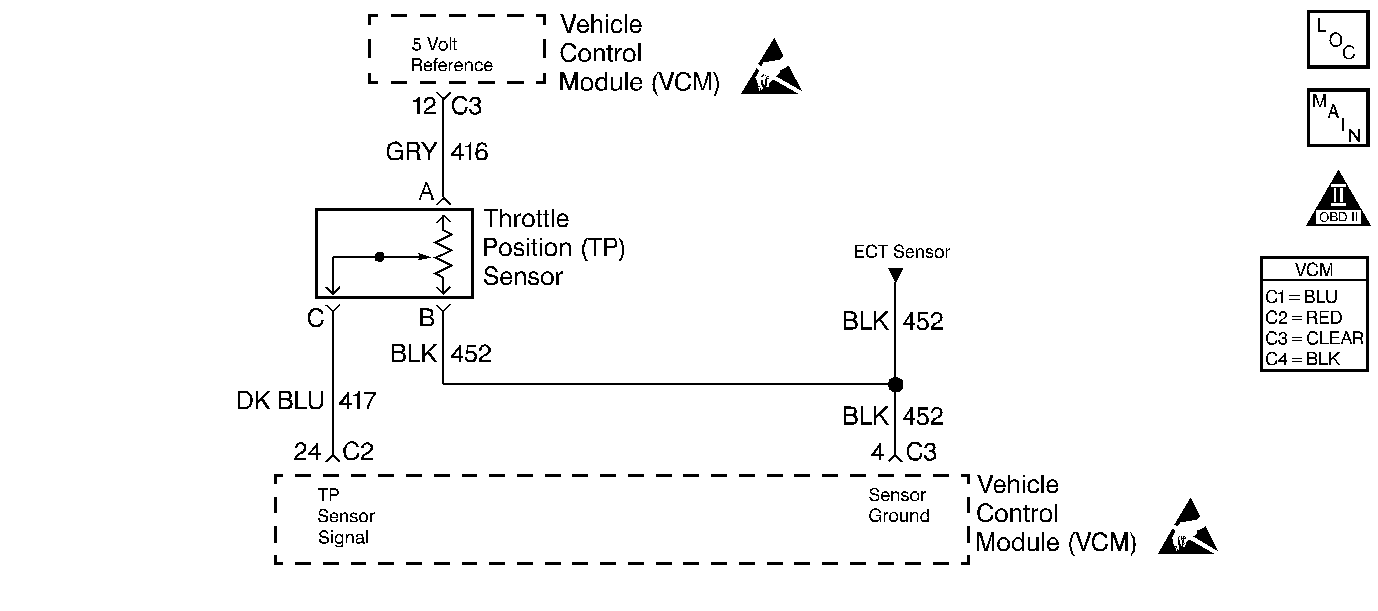
Circuit Description
The throttle position (TP) sensor is a potentiometer. The control module supplies the TP sensor a reference voltage, a signal, and ground circuits. When the throttle is depressed, the TP sensor signal rises to near the reference voltage. When the throttle is released, the TP sensor signal decreases from the reference voltage. The control module monitors the TP sensor signal circuit voltage in order to determine the throttle blade angle, or opening.
This DTC is designed to detect intermittent high signal voltage on the TP sensor signal circuit.
Conditions for Running the DTC
The engine has been running for more than 5 seconds.
Conditions for Setting the DTC
The TP sensor voltage is greater than 4.9 volts for more than 5 seconds.
Action Taken When the DTC Sets
The VCM stores the DTC in History if the VCM detects an intermittent problem.
Conditions for Clearing the MIL/DTC
| • | A history DTC will clear if no fault conditions have been detected for 40 warm-up cycles. |
| • | A warm-up cycle occurs when the coolant temperature has risen 22°C (40°F) from the startup coolant temperature and the engine coolant temperature exceeds 70°C (160°F) during the same ignition cycle. |
| • | Use the scan tool Clear Information function. |
Diagnostic Aids
The scan tool reads the throttle position in volts. The scan tool should read about 0.45 to 0.85 volt with the throttle closed and the ignition switch turned ON or at idle. The voltage should increase at a steady rate as the throttle is moved toward the wide open throttle (WOT).
Also, some scan tools will read the throttle angle. 0 percent = closed throttle. 100 percent = WOT.
Observe the TP sensor while depressing the accelerator pedal with the ignition turned ON leaving the engine OFF. The display should vary from about 0.5 volts (500 mV) when the throttle was closed to over 4.5 volts (4500 mV) when the throttle is held at the WOT position.
This DTC could set if the TP sensor ground circuit is intermittently open or the TP sensor signal circuit is intermittently shorted to voltage. If the high voltage reading is present, additional sensor circuit voltage codes could be set. Refer to any non-intermittent DTCs that are set.
An intermittent may be caused by a poor connection, rubbed through wire insulation, or a broken wire inside the insulation.
Thoroughly check any circuitry that is suspected of causing the intermittent complaint for the following conditions:
| • | Backed out terminals |
| • | Improper mating |
| • | Broken locks |
| • | Improperly formed or damaged terminals |
| • | Poor terminal to wire connections |
| • | Physical damage to the wiring harness |
| • | Corrosion |
| • | Moisture in the connector |
Test Description
The numbers below refer to the step numbers in the diagnostic table.
-
If the TP sensor voltage is greater than 4.9 volts, then the condition is present.
-
If any other non-intermittent DTCs are set go there first.
Step | Action | Value(s) | Yes | No |
|---|---|---|---|---|
1 |
Important: Before clearing the DTCs, use the scan tool Capture Info to save the Freeze Frame and Failure records for reference. The control module's data is deleted once the Clear Info function is used. Did you perform the Powertrain On-Board Diagnostic (OBD) System Check? | -- | ||
Is the TP sensor voltage greater than the specified value? | 4.9 V | |||
Are any non-intermittent DTCs set? | -- | Go to the applicable DTC table | ||
4 |
Did you find a problem? | -- | ||
5 |
Did you find a problem? | -- | ||
6 |
Did the voltage increase? | -- | Go to Diagnostic Aids | |
7 | Repair the circuit as necessary. Refer to Wiring Repairs . Is the action complete? | -- | -- | |
8 |
Does the scan tool indicate the diagnostic Passed? | -- | ||
9 | Does the scan tool display any additional undiagnosed DTCs? | -- | Go to the applicable DTC table | System OK |
